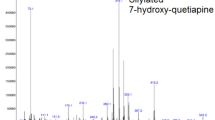Abstract
Purpose
The aim of this study was to assess the diagnostic value of catecholamines and their O-methylated metabolites in vitreous humor samples in identifying antemortem cold exposure and fatal hypothermia in the forensic casework.
Methods
A total of 80 autopsy cases (40 hypothermia fatalities and 40 cases in which hypothermia as the main or contributory cause of death was excluded) were selected for this study. Catecholamines and their O-methylated metabolites were measured in urine and vitreous humor samples collected at autopsy.
Results
Urine catecholamine and their O-methylated metabolite concentrations were significantly higher in hypothermia-related deaths. On the other hand, measurements in vitreous humor samples did not reveal statistically significant differences between hypothermia-related deaths and controls.
Conclusions
Globally considered, our findings seem to suggest that, contrary to urine catecholamines and their O-methylated metabolites, vitreous levels of these compounds appear to be of limited value in characterizing human antemortem stress reactions due to cold exposure and can hardly be used in the forensic setting to support the diagnosis of hypothermia.
Similar content being viewed by others
References
Palmiere C, Teresiński G, Hejna P, Mangin P, Grouzmann E. Diagnostic performance of urinary metanephrines for the postmortem diagnosis of hypothermia. Forensic Sci Med Pathol. 2014;10:518–25.
Goldstein DS, Eisenhofer G, Kopin IJ. Sources and significance of plasma levels of catechols and their metabolites in humans. J Pharmacol Exp Ther. 2003;305:800–11.
Nohta H, Mitsui A, Umegae Y, Ohkura Y. Determination of free and total catecholamines in human urine by HPLC with fluorescence detection. Biomed Chromatogr. 1987;2:9–12.
Grouzmann E, Lamine F. Determination of catecholamines in plasma and urine. Best Pract Res Clin Endocrinol Metab. 2013;27:713–23.
Jeyaraman K, Natarajan V, Thomas N, Jacob PM, Nair A, Shanthly N, et al. The role of urinary fractionated metanephrines in the diagnosis of phaeochromocytoma. Indian J Med Res. 2013;137:316–23.
Eisenhofer G, Huysmans F, Pacal K, Walther MM, Sweep FC, Lenders JW. Plasma metanephrines in renal failure. Kidney Int. 2005;67:668–77.
Pakanen L, Kortelainen ML, Särkioja T, Porvari K. Increased adrenaline to noradrenaline ratio is a superior indicator of antemortem hypothermia compared with separate catecholamine concentrations. J Forensic Sci. 2011;56:1213–8.
Lapinlampi TO, Hirvonen JI. Catecholamines in the vitreous fluid and urine of guinea pigs dying of cold and the effect of postmortem freezing and autolysis. J Forensic Sci. 1986;31:1357–65.
Teresiński G, Buszewicz G, Madro R. The influence of ethanol on the level of ketone bodies in hypothermia. Forensic Sci Int. 2002;127:88–96.
Grouzmann E, Fathi M, Gillet M, de Torrenté A, Cavadas C, Brunner H, Buclin T. Disappearance rate of catecholamines, total metanephrines, and neuropeptide Y from the plasma of patients after resection of pheochromocytoma. Clin Chem. 2001;47:1075–82.
Grouzmann E, Drouard-Troalen L, Baudin E, Plouin PF, Muller B, Grand D, et al. Diagnostic accuracy of free and total metanephrines in plasma and fractionated metanephrines in urine of patients with pheochromocytoma. Eur J Endocrinol. 2010;162:951–60.
Pussard E, Neveux M, Guineno N. Reference intervals for urinary catecholamines and metabolites from birth to adulthood. Clin Biochem. 2009;42:536–9.
Eisenhofer G, Kopin IJ, Goldstein DS. Catecholamine metabolism: a contemporary view with implications for physiology and medicine. Pharmacol Rev. 2004;56:331–49.
Glauser M, Metrailler M, Gerber-Lemaire S, Centeno C, Seghezzi C, Dunand M, et al. Enzyme and acid deconjugation of plasma sulfated metanephrines. Clin Chim Acta. 2014;430:125–8.
Eisenhofer G. Free or total metanephrines for diagnosis of pheochromocytoma: what is the difference? Clin Chem. 2001;47:988–9.
Eisenhofer G, Lenders JW. Pacak. Biochemical diagnosis of pheochromocytoma. Front Horm Res. 2004;31:76–106.
Hirvonen J, Huttunen P. Increased urinary concentration of catecholamines in hypothermia deaths. J Forensic Sci. 1982;27:264–71.
Ishikawa T, Inamori-Kawamoto O, Quan L, Michiue T, Chen JH, Wang Q, et al. Postmortem urinary catecholamine levels with regard to the cause of death. Leg Med (Tokyo). 2014;16:344–9.
Tormey WP, Carney M, FitzGerald RJ. Catecholamines in urine after death. Forensic Sci Int. 1999;103:67–71.
Wilke N, Janssen H, Fahrenhorst C, Hecker H, Manns MP, Brabant EG, et al. Postmortem determination of concentrations of stress hormones in various body fluids - is there a dependency between adrenaline/noradrenaline quotient, cause of death and agony time. Int J Legal Med. 2007;121:385–94.
Kernbach-Wighton G. Diagnostic problems with functional cause of death: analytical approaches and procedures. Leg Med (Tokyo). 2009;11(Suppl 1):S31–5.
Zhu BL, Ishikawa T, Michiue T, Li DR, Zhao D, Quan L, et al. Postmortem serum catecholamine levels in relation to the cause of death. Forensic Sci Int. 2007;173:122–9.
Ishikawa T, Quan L, Michiue T, Kawamoto O, Wang Q, Chen JH, et al. Postmortem catecholamine levels in pericardial and cerebrospinal fluids with regard to the cause of death in medicolegal autopsy. Forensic Sci Int. 2013;228:52–60.
Kernbach-Wighton G, Sprung R, Saternus K-S. Zum Katecholaminspeigel bei Unterkühlung. 11 Frühjahrstatung der Deutschen Gesellshaft für Rechtsmedizin, Region Nord, 31 May–1 June 2002. Potsdam Rechtsmed. 2003;1:44–45.
Author information
Authors and Affiliations
Corresponding author
Rights and permissions
About this article
Cite this article
Hervet, T., Teresiński, G., Hejna, P. et al. Catecholamines and their O-methylated metabolites in vitreous humor in hypothermia cases. Forensic Sci Med Pathol 12, 163–169 (2016). https://doi.org/10.1007/s12024-016-9764-2
Accepted:
Published:
Issue Date:
DOI: https://doi.org/10.1007/s12024-016-9764-2




